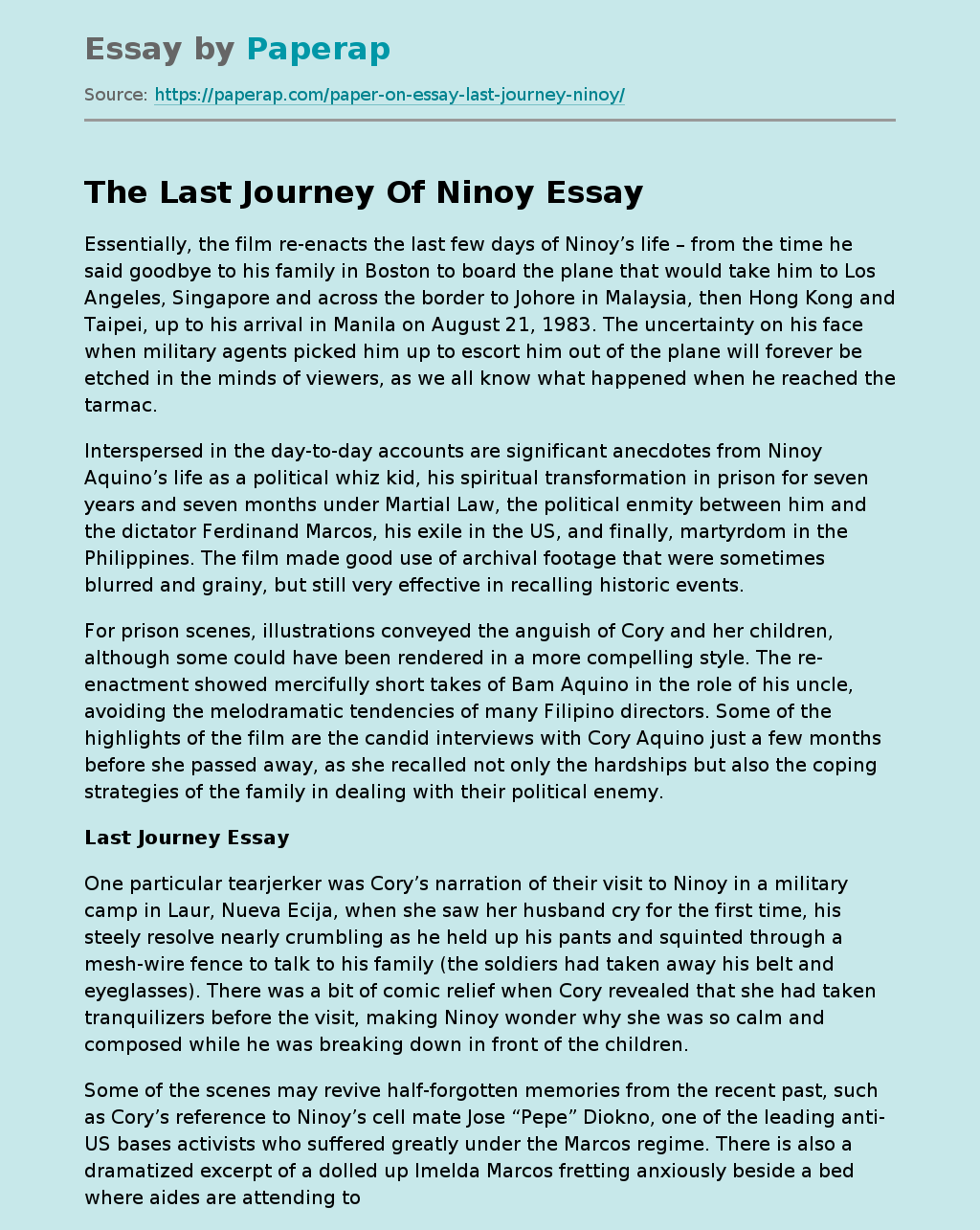The Last Journey Of Ninoy
Essentially, the film re-enacts the last few days of Ninoy’s life – from the time he said goodbye to his family in Boston to board the plane that would take him to Los Angeles, Singapore and across the border to Johore in Malaysia, then Hong Kong and Taipei, up to his arrival in Manila on August 21, 1983. The uncertainty on his face when military agents picked him up to escort him out of the plane will forever be etched in the minds of viewers, as we all know what happened when he reached the tarmac.
Interspersed in the day-to-day accounts are significant anecdotes from Ninoy Aquino’s life as a political whiz kid, his spiritual transformation in prison for seven years and seven months under Martial Law, the political enmity between him and the dictator Ferdinand Marcos, his exile in the US, and finally, martyrdom in the Philippines. The film made good use of archival footage that were sometimes blurred and grainy, but still very effective in recalling historic events.
For prison scenes, illustrations conveyed the anguish of Cory and her children, although some could have been rendered in a more compelling style. The re-enactment showed mercifully short takes of Bam Aquino in the role of his uncle, avoiding the melodramatic tendencies of many Filipino directors. Some of the highlights of the film are the candid interviews with Cory Aquino just a few months before she passed away, as she recalled not only the hardships but also the coping strategies of the family in dealing with their political enemy.
Last Journey Essay
One particular tearjerker was Cory’s narration of their visit to Ninoy in a military camp in Laur, Nueva Ecija, when she saw her husband cry for the first time, his steely resolve nearly crumbling as he held up his pants and squinted through a mesh-wire fence to talk to his family (the soldiers had taken away his belt and eyeglasses). There was a bit of comic relief when Cory revealed that she had taken tranquilizers before the visit, making Ninoy wonder why she was so calm and composed while he was breaking down in front of the children.
Some of the scenes may revive half-forgotten memories from the recent past, such as Cory’s reference to Ninoy’s cell mate Jose “Pepe” Diokno, one of the leading anti-US bases activists who suffered greatly under the Marcos regime. There is also a dramatized excerpt of a dolled up Imelda Marcos fretting anxiously beside a bed where aides are attending to her unconscious husband, tubes and all. Unfortunately, the caricature diminishes the impact of the scene’s message: the persistent conspiracy theory that she and some generals may have known ore about Ninoy’s assassination than Ferdinand Marcos, who was reportedly incapacitated at that time. The snippets of Ninoy’s speeches juxtaposed with sound bites of Marcos showed both men at the peak of their form: one relishing his political power, the other recalling his ordeal in prison. The good versus evil conflict predictably puts the spotlight on the redemption of Ninoy; it is his film, after all – but unwittingly, it also shows the tragedy of Marcos as a Gollum-like character clinging desperately to Malacanang.
In the scene where Ninoy lashes out at Marcos’ plans to change the form of government from presidential to parliamentary so he could prolong his stay in the palace, one could almost hear the same thought running through the viewers’ minds: sounds like the current occupant of Malacanang, isn’t it? Next month, the country marks the 37th anniversary of Martial Law. It would be good if “The Last Journey of Ninoy” is shown at the House of Representatives, where the lessons from that bleak chapter in the nation’s history have yet to sink in.
Better yet, it should be required viewing for all politicians who have a hard time letting go. Ultimately, they would have to confront the question: do they want to be remembered with fondness like Ninoy and Cory, or do they want to be vilified like Ferdinand and Imelda? During their lifetime, Cory and Ninoy displayed leadership and nobility in serving both home and country. “The Last Journey of Ninoy” demonstrates the power of mass media in bringing such stories to life.
In watching this film, Filipinos will not only remember the past, but more importantly, they may learn from the insights of those who have gone before them Ninoy was truly an exceptional and inspiring man. Hard-working, immensely intelligent, passionate, prayerful and noble, he dedicated his life to public service and, in the latter years of his life, took a stand against the death of democracy in the Philippines. He went through so much pain and loneliness in his struggles, but he was resilient and continued to fight for our freedom.
He often said that he was not afraid of dying, and it’s moving to see how much he was willing to give up for this fight. These days, we see our politicians swinging from one party to another, to wherever they think will give them a better chance at winning. It seems that parties — or politicians, for that matter — no longer stand for any one ideology. In Ninoy’s case, you see his beliefs in everything he does — his hunger strike, his seven years in prison, and his attempt to return to Manila. Actions speak louder than words after all.
The Last Journey Of Ninoy. (2019, Dec 05). Retrieved from https://paperap.com/paper-on-essay-last-journey-ninoy/

